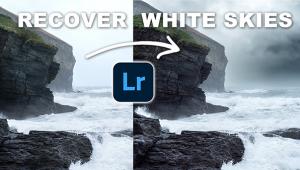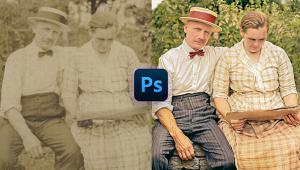Future Report
A Look At What's Ahead For Photography In 2005...And Beyond
Each year at this time we ask our contributors to give us their forecast for
the coming year in photography. While some of their predictions are, well, predictable,
a few surprised me with their call for a return to film. This is not mere Luddite
doggerel. Clearly digital has changed the way we all operate these days, but
there are some lingering doubts about how viable the medium will be five or
10 years down the road, especially with what we are working with today. Whether
it's too late to go back to film is a big question, one that not everyone
feels need be answered. The digital converts, at least on the industry and manufacturer
side, are clearly in control.
For my part I feel that the coming year will be one in which the industry needs
to deal with standards. For example, Adobe's recent call for a raw standard,
one that does away with all the proprietary cluster of raw formats today, seems
sensible enough. Having wrestled with just about every raw format around it's
probably an idea that needs to be examined, especially since this software giant
sees all the present and future raw formats as somewhat of a ticking time bomb.
The idea that you might not be able to open current digital images on future
software, regardless of the reader you might have kept around, is one that fills
us all with fear and loathing.
Adobe's proposed standard that they think will stop the madness is their
Digital Negative Raw, dubbed DNG. They have set up a website with the specs
and invite camera makers to jump in and join a universal raw format movement.
This would be a cross-camera raw in Version 1 form that would follow a progression
and always (they say) be backward compatible.
Another indication of trouble in digital-ville is the formation of what's
called the PASS Group, the Picture Archiving and Sharing Standard coalition.
The aim of this group is to develop a set of open standards for the preservation
of digital photos on CDs, etc., to "maintain digital file capability with
future playback devices." It will hopefully define the requirements for
future authoring, playback, and printing devices and (my emphasis) "unify
the existing multiple standards so that generations to come can enjoy the images
we make today." Oh? Don't we have that now? Well, I guess not because
the PASS Group wants to ensure that "digital images can be retrieved from
any digital device or storage medium." I'll let you draw your own
conclusions on that one.
Getting standards would be a good thing, but this standardization will necessarily
come at the obsolescence of what you have on your desktop today, and that's
not a good thing if you just bought the latest gizmo. One case in point is a
system Kodak introduced at photokina called Imagelink. It's a connector
system that allows cameras from multiple makers to plug into various dye sub
printer docks, the portable printers that kick out fast and quite nice 4x6 prints.
It seems that the old system (read the one you might have now) had a 22-pin
connector. This will now be a 26-pin connector, and digicams from folks like
Konica Minolta, Nikon, Olympus, Pentax, Ricoh, and Sanyo (and of course Kodak)
have joined the Imagelink group. Most will be happy to sell you an adapter cradle
to go from your present 22 connector to the new 26-pin design, but some will
need wired connectors to work.
But you can't stop the changes, especially when they're for the
better. You might have thought that when you got Windows XP Pro that you had
the latest and greatest, and for that six month or so window you had. But early
next year the new standard for digital imagers will be XP Pro x64, a faster
setup that takes advantage of 64-bit chips. We saw a demo and when used with
Photoshop CS it virtually stitched a bunch of large image files into an 84MB
file in about 6 seconds. You may not need such demonish speed, but for those
who do lots of imaging work it will be very tempting.
Another proposal being floated is from Lexar, who want digicam makers to adopt
something they call "Active Memory" that would be added onto memory
cards. Here's how it would work: You can apply a bit of data to a card
that would be excluded from erasure whenever you format your card. This piece
of information could contain your name, copyright notice, etc., as well as could
be set up with preprogrammed captioning for the day's shoot. Then when
you plug the camera into the computer to download it would automatically open
Photo Mechanic software and all the images would be labeled and ready to go,
with keywords and all.
But it goes beyond just captioning, although that ain't bad. Theoretically
if you had a camera maker's cooperation you could have the data set up
to program the camera's setting whenever you use a particular card. So,
you could have one card set up for ISO 800 tungsten, another for daylight white
balance and high color saturation, etc. If that sounds like loading a particular
film to get a certain look or color balance you're right. There are other
scenarios for personalized cards that make this proposal more than one of just
passing interest, although old timers might recognize the card system used in
Minolta film SLRs in the late 1980s, a precursor to Scene modes.
Did I say attach a camera for downloading? That may be passé very soon,
as the wireless fever has hit data transfer. Both the new Canon EOS-1Ds Mark
II, a 16.7-megapixel digital SLR, and the new Nikon D2X, a 12.4-megapixel digital
SLR, allow for the addition of an optional transmitter to send images from camera
to computer without wires or card reader.
But more than one camera maker and data company (including cell phone companies
who are looking at the photo industry with big eyes) are working on wireless
image file transfer and printing. Yes, we've had Bluetooth, and while
slow and often cumbersome it is a rather amazing setup. But now we will have
something called MTP, for Media Transfer Protocol. Touted by Microsoft, this
allows for easy setup via Wizards of a wireless system for all sorts of imaging
work, in the home studio or sports arena of your choice. They describe the system
as one that "anyone can set up" as long as all systems have the
ability to send and, of course, receive. This is also being seen as something
that every digicam will have in the future and we might see folks downloading
images from their cameras to their laptops in hot spots like the inevitable
Starbucks, all sans wires.
As we delve further into actual products in our photokina reports in this issue
we'll show you some of the actual products that may alter the way we look
at our photographic tools. There's no question that photography is changing
faster than you can imagine and that one of the main by-products of this new
technology is obsolescence. But that, my friend, is what has been happening
in the photo industry of late. In some cases manufacturers are gaining market
share by making sure their competitor's products are out of date faster
than their own.
So, with that in mind, here are the thoughts of our sage contributors, folks
who live, breathe, and pay the rent with their photography every day.
--George Schaub
Portrait Photographer Forecast: Gray Skies Ahead
Some things are easy to forecast--more megapixels at lower cost, expanded
dynamic range with digital cameras, faster lenses with more focal length range,
etc. I'm going to forecast the future for the professional portrait photographer,
and it isn't pretty.
First, the wedding market will continue to deteriorate. It's already in
substantial decline. I believe there are two reasons for this. First, digital.
As a pro, I know that it's still easier to produce quality images with
film if you're a novice. But they don't know that, and the ability
to see the image right after capture gives them the confidence to know that
they've "got it." Combine that with the photojournalistic
style that photographers have embraced, and you can see why many amateurs think
they can handle the job. Only the very cheap and high-end photographers will
enjoy success--the middle guy is gone.
In portraits, I see the same thing happening to the high school senior market.
Over the last 10 years, I've seen more and more schools let seniors put
in whatever photos they want, with "no specs." Photographers cheered
this move because it allowed them to put more "creative" images
in, but as in wedding photojournalism, I believe they've become their
own worst enemy. We hear more and more, "My friend's mom is going
to take my pictures." She'll take Johnny with his kayak by the river
at noon and everyone's happy. Another job lost.
What to do? I think the correct approach is to do what they can't. I'm
placing a renewed emphasis on very classic studio portraiture, which will never
go out of style and Johnny's mom can't do. Sorry to be so negative,
but time will tell if I'm correct. I see digital as both the greatest
tool and also the greatest enemy to the professional portrait photographer.
--Steve Bedell
Looking Ahead After Looking Back
It has been about 15 years now that I have been doing photography digitally
and using a computer as a darkroom. Looking back over the experience and at
the current state of the art of digital photography, it seems much like looking
back at how a child grows, and at about the same pace in terms of where digital
photography is today. In this last two or three years it has seemed like the
tumultuous spurts of growth of an adolescent. But today there are signs of digital
photography taking a more developed shape, with features and characteristics
beginning to appear that hint at what form it could possibly take as a mature
adult. But juveniles are notoriously unpredictable so I will not stick my neck
out much by making detailed prognostications.
However, some of the things I am looking at that are new indicate a maturing
focus by the entire digital photography industry. It seems now that the pipeline
has been filled with consumer digital cameras, and for several years now, many
experienced digital camera users have been looking to upgrade to more sophisticated
cameras that look and perform more like what the professionals have been using
for some time. In addition, more cameras like the Canon EOS Digital Rebel are
selling in significant numbers. This seems to be encouraging both prime camera
makers and the established independent lens manufacturers to begin a serious
move to supply lenses specifically designed for the "2/3" chip size
(1.5x focal length factor) cameras as more and more models from almost every
manufacturer become available.
Other signs of maturation include Adobe's new Photoshop Elements 3.0 with
full support of digital camera raw files, not to mention Adobe's new Digital
Negative .DNG file format initiative, immediately offering users the opportunity
to convert camera brand proprietary raw formats to Adobe .DNG for archiving
purposes. Of course, how wise a strategy that is depends on the extent to which
camera manufacturers adopt the Adobe .DNG file format, something that is not
at all certain.
A couple more signs of digital photography maturing that are less obvious come
from new printers, and the information about Microsoft's next major operating
system upgrade currently named "longhorn." Two of the new ink jets
I reported on recently, the Epson Stylus Photo R800 and the Canon i9900, both
have ink color configurations that depart from the standard CcMmYK of the past.
Although this resolves a problem due to an inherent weakness in magenta inks,
it also provides improved photo-realistic printing and reproduction of colors
that are truer to reality. In Microsoft's case, information about their
next operating system published on their website indicates that the company
now recognizes that their promotion and implementation, with partners Intel
and HP, of the sRGB color space standard ill-served color reproduction and digital
photography. Now they claim to be working on an entirely new approach to color
management that is not based on the established ICC standard. I applaud the
candor and good intentions, but let's hope the people at Microsoft have
not again bitten off more than they can chew--they have already abandoned
some new "longhorn" feature goals, so let's hope their new
color management makes deadline and that it works.
--David B. Brooks

































